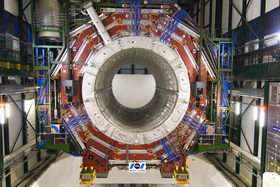Slowly does it as giant magnet goes underground at CERN

At 5:00 am GMT this morning the heaviest piece of the Compact Muon Solenoid (CMS) particle detector began a momentous journey into its experimental cavern, 100 metres underground at CERN, Geneva. You can watch it on the webcam link.
Physicists are preparing the CMS detector and its sister detector, ATLAS, to take data at CERN's Large Hadron Collider, where scientists predict that they will make fundamental discoveries about the universe, using very-high-energy proton collisions. Beyond revealing a new world of unknown particles, the LHC experiments could explain why those particles exist and behave as they do. They could discover the origins of mass, shed light on dark matter, uncover hidden symmetries of the universe, and possibly find extra dimensions of space.
Using a huge gantry crane, custom-built by VSL group, the pre-assembled central piece of the detector, weighing as much as five Jumbo jets (1920 tonnes) is being gently lowered into place. "This is a challenging feat of engineering, as there are just 20 cm of leeway between the detector and the walls of the shaft," said Austin Ball, Technical Coordinator of CMS. "The detector is supported by four massive cables, each with 55 strands and attached to a step-by-step hydraulic jacking system, with sophisticated monitoring and control to ensure the object does not sway or tilt." The entire process is expected to take about ten hours to complete.
The first seven of 15 pieces of the CMS detector have already been lowered, with the first piece arriving in the experimental cavern on 30 November 2006. The giant element being lowered today, which is 16 m tall, 17 m wide and 13 m long, marks the halfway point in the lowering process with the last piece scheduled to make its descent in summer 2007.
Professor Keith Mason, CEO of the Particle Physics and Astronomy Council (PPARC), which pays the UK subscription to CERN, said "The lowering of the largest piece of CMS today marks a major engineering milestone towards the switch on of the Large Hadron Collider (LHC) later this year. It is somewhat of a paradox that the largest, heaviest detectors ever built will be used to study the smallest scientific events."
The construction of CMS is a unique experience for the high-energy physics collaboration, as typically such experiments are built underground – without the need for moving and lowering large pieces. CMS has broken with tradition in order to start assembly before completion of the underground cavern, taking advantage of a spacious surface assembly hall to pre-assemble and pre-test the solenoid magnet and the various detectors used to measure particles resulting from collisions.
CMS is a general purpose experiment being prepared to take data at CERN's LHC which will be the world's largest and most complex scientific instrument when it switches on in November 2007.
Experiments at the LHC will allow physicists to complete a journey that started with Newton's description of gravity. Gravity acts on mass, but so far science is unable to explain why the fundamental particles have the masses they have. Experiments such as CMS may provide the answer. LHC experiments will also probe the mysterious missing mass and dark energy of the universe – visible matter seems to account for just 4% of what must exist. They will investigate the reason for nature's preference for matter over antimatter, and will probe matter as it existed at the very beginning of time.
"This is a very exciting time for physics," said CMS spokesman Jim Virdee from Imperial College London, "the LHC is poised to take us to a new level of understanding of our Universe."
Dr Helen Heath, a CMS collaboration member from the University of Bristol said, "This is a very exciting time as the experiment many of us have worked on for over 10 years begins to come together."
Source: Particle Physics & Astronomy Research Council





















